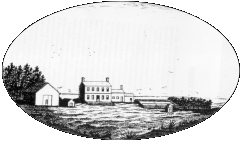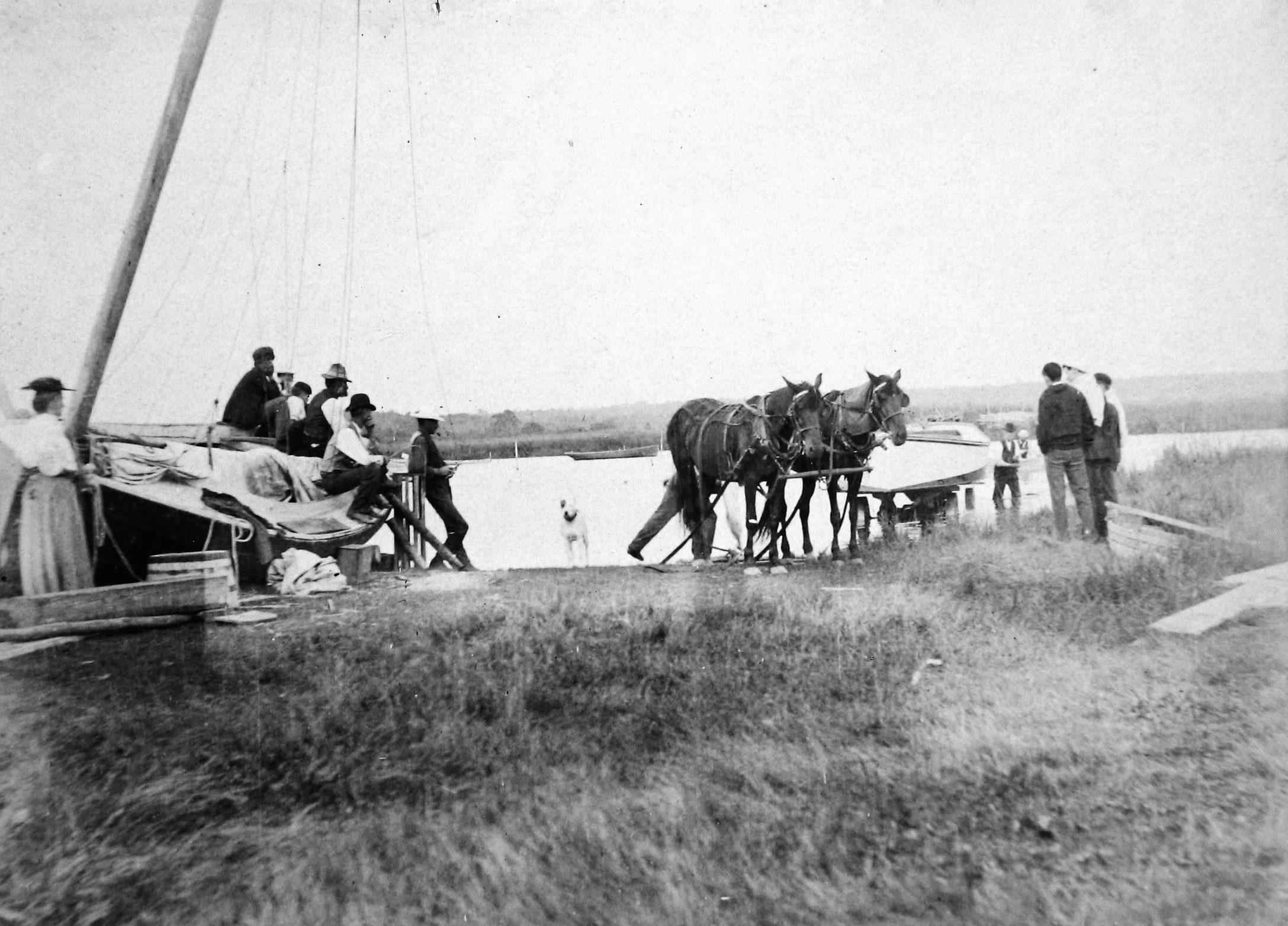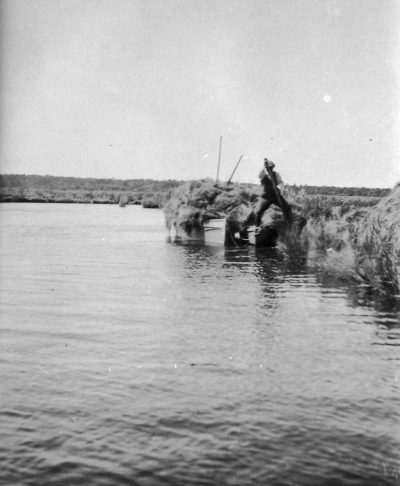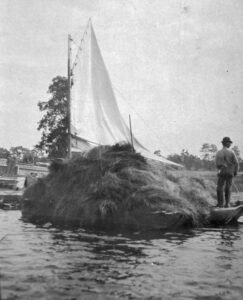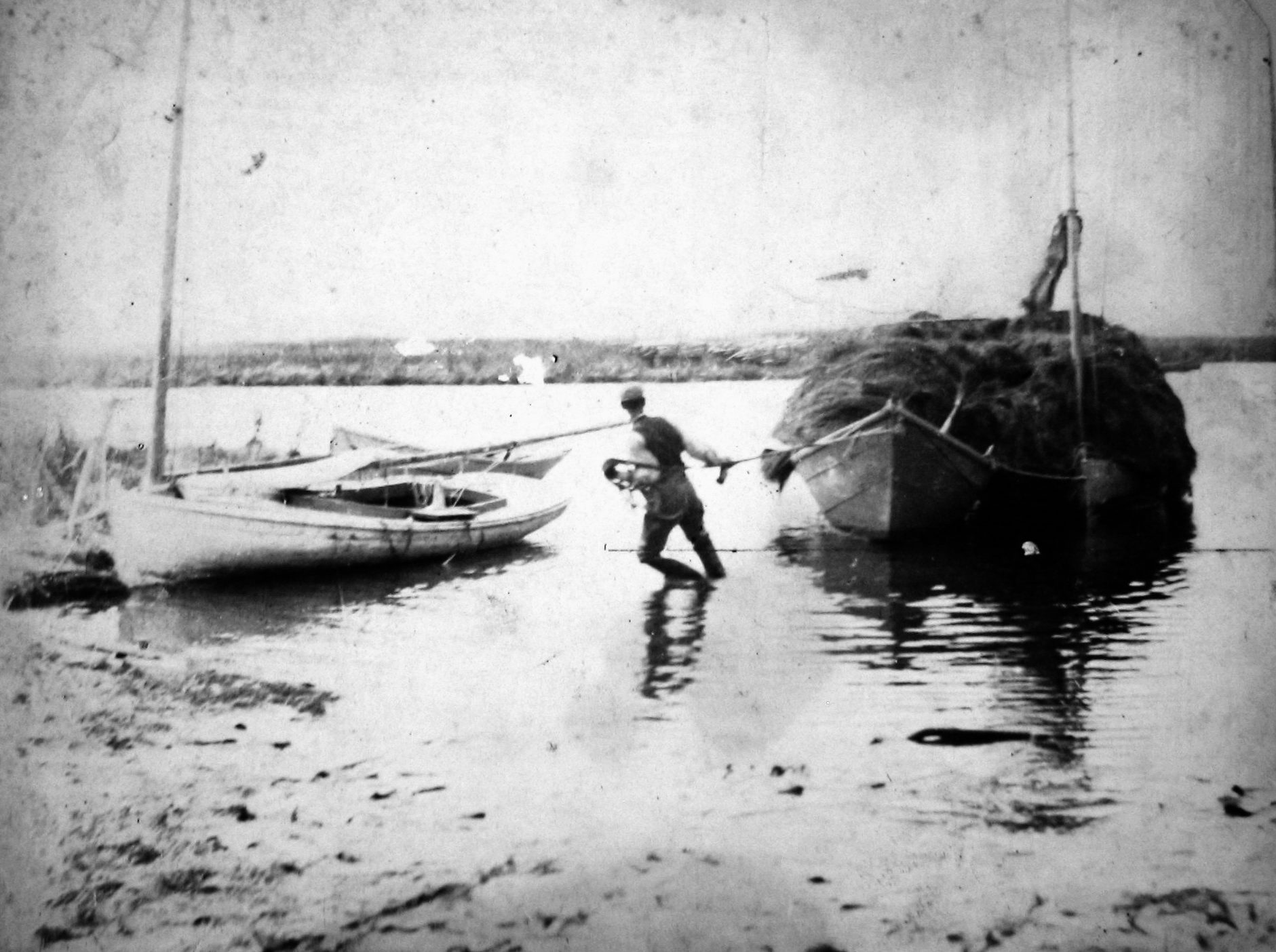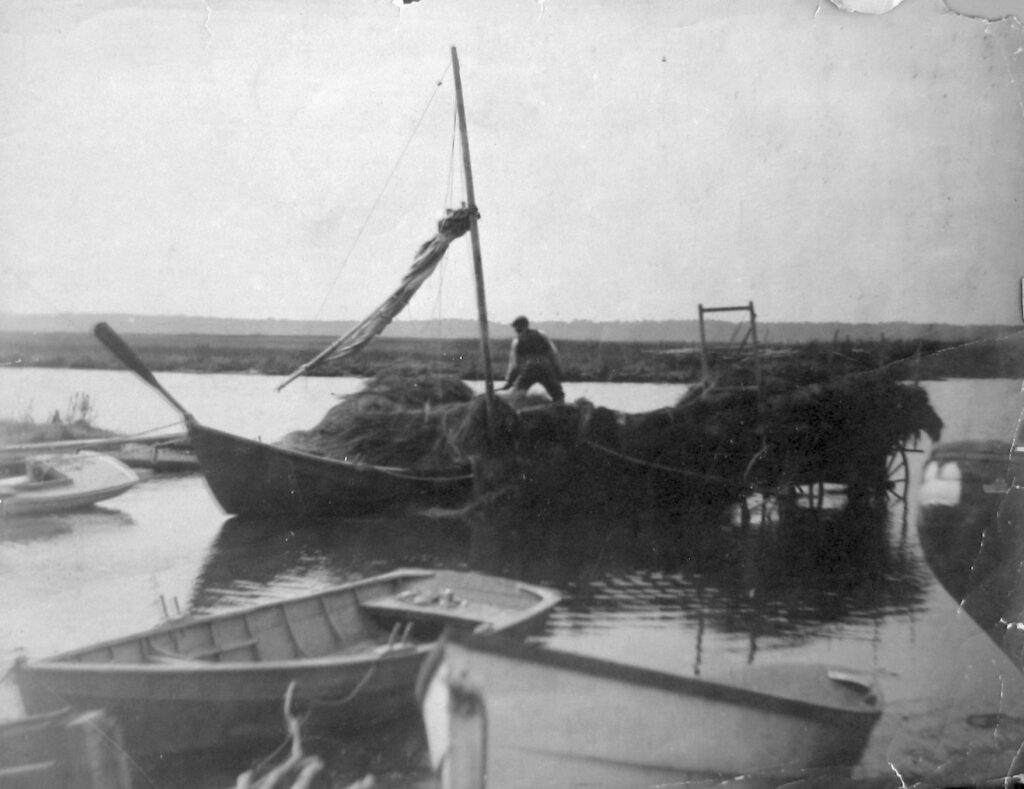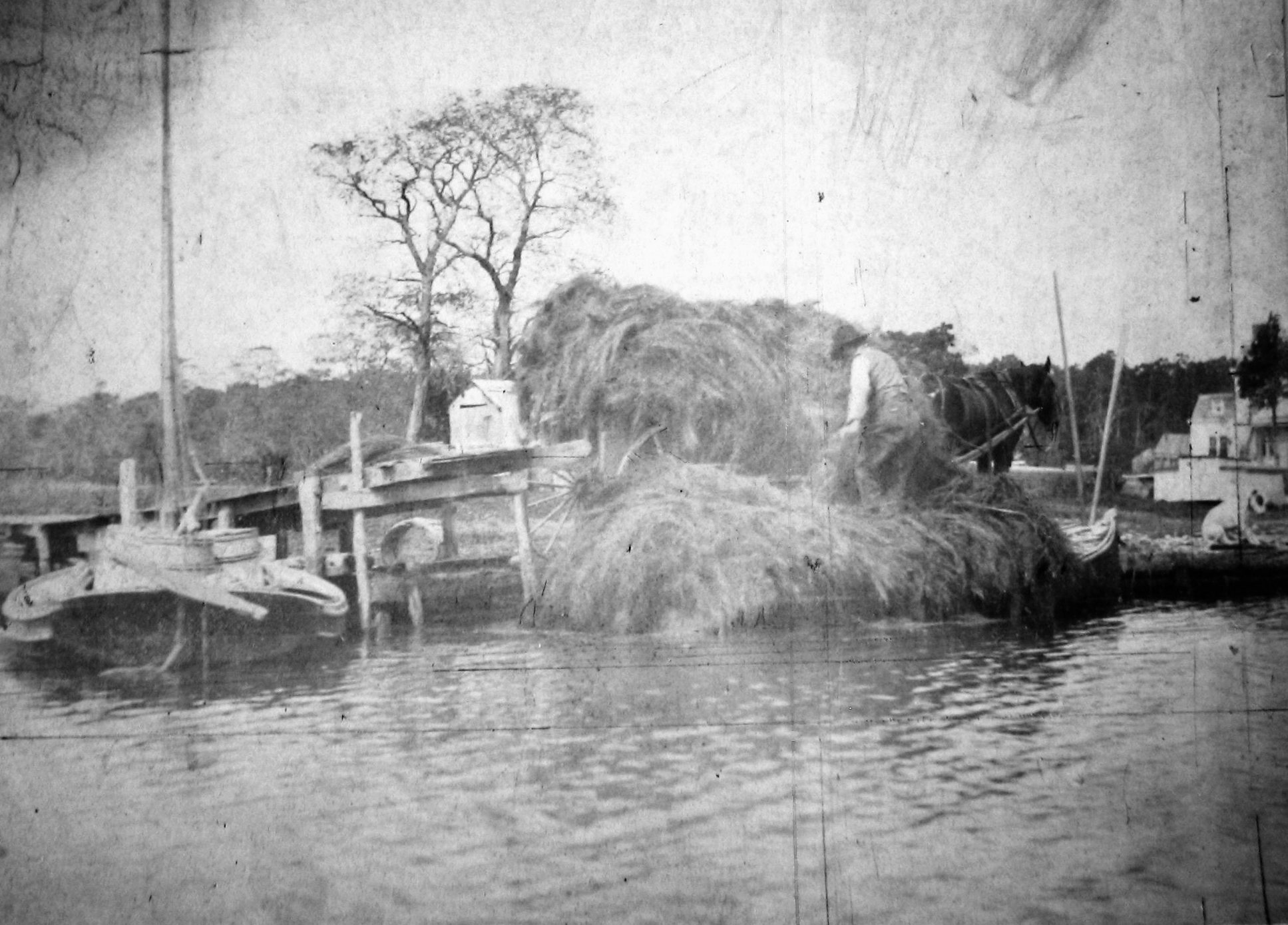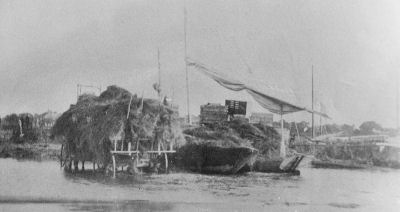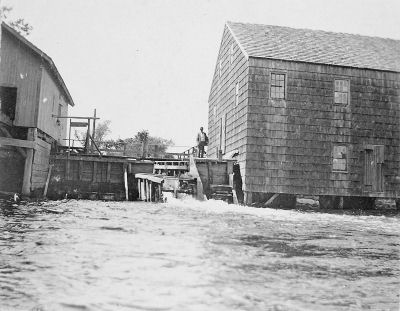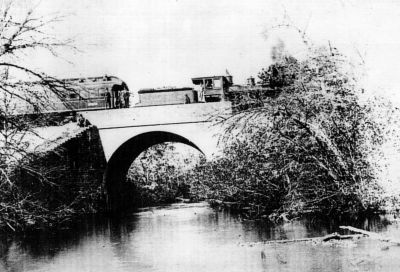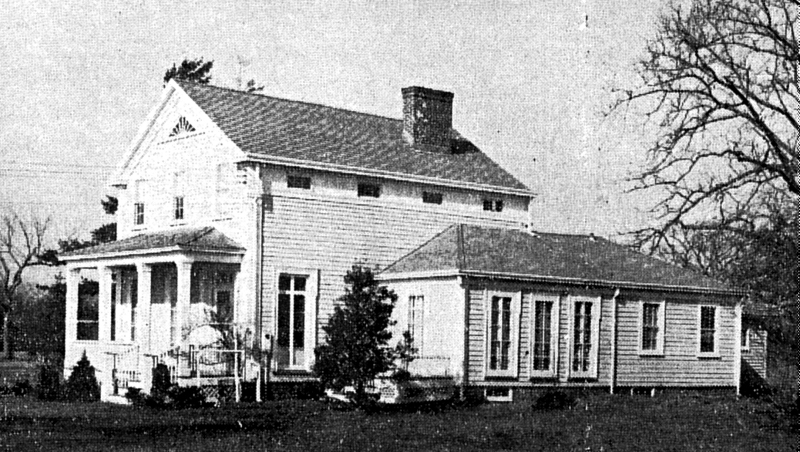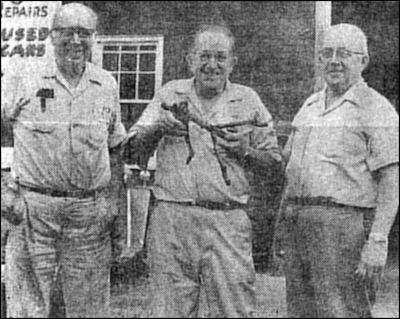HISTORY OF THE OLD INLET & FIRE PLACE BEACH CLUBS
by Bob Starke
Recorded Jan 23, 2003
Revision 1, by Bob Starke, January 28, 2003
Revision 2, by Bob and Helen Starke, February 5, 2003
was born in 1916 and I’ll be 87 years old on Feb. 11 this year. My father had brought this property in Brookhaven [68 Bay Road] in 1900 along with his brother, Charles. Pop had 22 acres and Charles had 14, so we had all the property from where the house is now to the Bay. My mother died shortly after I was born so I was raised by a housekeeper here with my brother, Newell, who was six years older than I. I went to school out here, for the 1st, 2nd and 3rd grade. After pop married again we lived in the city, in Flatbush, and so we only came out here during the summer. But for my first school years I went to the schoolhouse here on Fire Place Neck Road. The old schoolhouse was where the current elementary school is today, but was an old wooden building, two stories, the ground floor had four classes and the upstairs had the other four. Only three people ran the school, two teachers and a custodian.
After the war and my discharge from the Navy in 1946, Helen and I wanted to live in Brookhaven and for a while used the old barn, which was renovated into a house for a year and a half. At that time, 1947, my stepmother, since we had homes in Flatbush and in Brookhaven, decided to sell the Brookhaven property. Accordingly, it was listed for sale and Daniel Bohan, a developer from Bellport, made an offer of $25,000 for the house-barn [now 1 River Lane] and 22 acres. I opted for the house [68 Bay Road] and property to the Beaver Dam Creek, a plot 200 feet on Bay Road and 150 on the creek, a total of about four acres, which we still own today. We also bought an additional three acres, the property adjacent and just north of us, from Mrs. Morasco.
A few years went by and I was voted in as president of the Brookhaven Village Association. The most important matter on our agenda at the time was the original Tiger Nursery property, which was sold a number of times and finally ended up in the hands of Mr. Gallo. Mr. Gallo wanted a change in zoning to permit a large number of small houses to be built. Everyone in Brookhaven Hamlet was edgy seeing what had happened to my father’s old property [now Clover, Bay and River Lanes] and what was going on in Shirley just to the east of South Haven. To fight this situation, we, the BVA, engaged Peter Snyder as our attorney and he was a great help, and I believe never charged us except for out-of-pocket expenses. He suggested and we hired an expert consultant on land use and we won out as the zoning change request was denied.
Now let’s talk about the history of Old Inlet and the Fire Place Beach Club. The two clubs that were there were very different from each other in this respect that the Old Inlet was a private beach club with a regular membership committee, and if you wanted to belong to the Old Inlet Club you got a hold of a member and had to be nominated by at least one member. It was open to Brookhaven Hamlet residents, too, but there were few. My father was a member, as were the Wellingtons and the Huberts, but I don’t know if Mr. Post belonged.
During this time this was the only club in the area on the beach except for the Smith’s Point House and that was run by the Nesbitt family. They had bathhouses there, a dock, and they had surf-shore dinners occasionally, usually on Sundays. It was located west of where the current bridge is, just opposite the real Smith’s Point, close to where the Coast Guard station was.
There were two ferries, sailboats, from Brookhaven. The first was run by Blyth Gerard and his boat was called the Fanny Fern. The other one was called the Woodmere [run by Frank Smith], and they went to Smith’s Point and that was the only other access to the beach other than the Old Inlet Club in the early days. There was no reason to have a Brookhaven beach club because we had ferries going to the Smith’s Point House from Carmans River. They were in competition with each other and both were sailboats, but I think the Fanny Fern had a kicker with it, a little one-cylinder engine.
[The wooden bridges built in 1916, 1921 and 1927, spanning the area where the current Smith’s Point Bridge stands, lasted only a few years each as winter storms and ice destroyed them]. It was great snapper fishing from the wooden Smith’s Point bridge built in 1927, in fact, when I was 12 years old I got a boat of my own, a little sailboat, and I used to go over to Clint Miller’s. He had a little shack on the beach and hauled for bait, and I used to sell bait to the snapper fishermen on the bridge. I used to get 25 cents a quart for shiners. There was a hotel on the beach side of the bridge, it was called the Hedges Hotel, but I don’t know who owned the hotel. I also don’t know who paid to have the wooden bridges built. But Smith’s Point was really the Nesbitt beach house over near the Coast Guard Station. The boats and ferries would come in on the long dock they had there. One of my most memorable childhood experiences on the beach was before 1930 when the Betsy White wrecked and broke in half with the bow section landing west of Old Inlet and stern section to the east. She was “visited” by lots of locals, my brothers Newell, Bill and I included. We ended up with a piece of the anchor chain, which laid under our front porch for years. Other locals cut up the rest of the chain, hauled it back to the mainland and later the fire department used it for the restoration of the Brookhaven Hamlet memorial which they encircled with the chain. However, they were a few pieces short so I gave them my pieces to complete it.
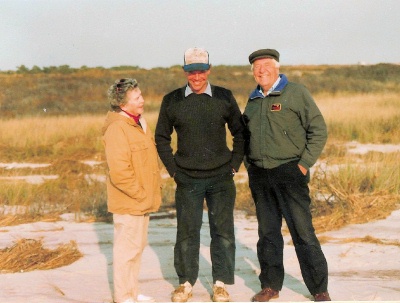
Helen, son Bill, and Bob Starke at site of Old Inlet Club, 1991
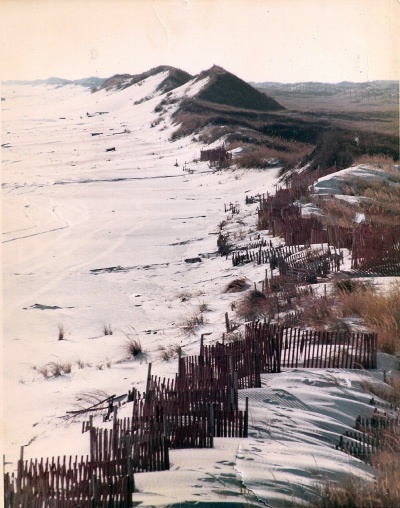
Dunes at the Old Inlet Beach Club area about 1960
Photo: © Marshall Bull
The Old Inlet Club was exactly where the current, 2003, boardwalk crossing is. Before the ’38 hurricane, Old Inlet had a place where you could get a sandwich or a cup of coffee and so on, and they had bathhouses and you rented them for the season. And they had family houses and they had women’s court and a men’s court, which were just lockers, and they had freshwater showers. Then the hurricane of ’38 came along and wiped everything out, including Nesbitt’s Smith Point House, which was never rebuilt. We [the Old Inlet Club members] had a meeting right after the hurricane and decided to rebuild the whole thing. Ted Everett had a new water tank made out of cypress and Ted towed it over to the beach. We rolled it up the boardwalk to a little promontory on the dune on the west side of the boardwalk down where the bathhouses were. Fortunately, the hurricane did not destroy the old pumping engine, which was an old, one-cylinder Fairbanks & Morse make-and-break connected to a freshwater well. We also had to replace the cesspools, which were located on the beach. Everything was put back in good shape. The members that chipped in to rebuild Old Inlet were noted in the record as equity members, and it came to pass later when the property was sold to the National Seashore those members who rebuilt the club got extra compensation. So, in short, after we rebuilt it Old Inlet resumed as before.
Now let’s talk about the 1950s and the creation of the Fire Place Beach Club. How that came to pass was that I was president of the Brookhaven Village Association at the time and we more or less decided that with the threat of Robert Moses’ plan to build a highway down the middle of Fire Island and also the interest in it becoming a National Seashore, if we wanted to have our own access to the beach and a beach club we’d better damn well buy a piece. We bought a stretch, from bay to ocean, that was 200’ wide from the Tibbs girls, Nancy Llungqvist and Barbara Horan. It was altogether, I believe, about five acres. We asked ourselves “How are we going to get the money to buy this piece?” So, we decided to follow what Old Inlet originally did. They had established the Hospital Point company and they bought the property and leased it to the Old Inlet Club and they put out bonds and stock in the Hospital Point Company. [As an aside, Hospital Point, which is adjacent to where the Old Inlet Club was to be built, got its name from an incident that happened in the early 1900s. Because of the deep water there, the Coast Guard used that point to rescue shipwrecked people and took them to Bellport for help.]
So we did the same. But we didn’t have a company. But like Old Inlet, which was not connected to the incorporated village, we were a private club. We thought of incorporating at the time but it was too much a complication, so we formed the Mattabank Corporation. It’s an Indian name for the barrier beach. We told the people of Brookhaven they could buy one share of stock for $25 and one bond which was $100. And the bond would pay 6% interest. We sold enough stocks and bonds to pay the $3,000 an acre, or $15,000 for the lot. I don’t remember the exact date, but it was somewhere in the mid-1950s. We then leased it to the BVA who, in turn, named it the Fire Place Beach Club.
The Fire Place Beach Club was different from the Old Inlet Club in this respect: The Old Inlet Club was a private club, as we [BVA] were, but our members were restricted to a geographic area – Brookhaven Hamlet. We did not have the non-residents same arrangement as we did with Squassux Landing, where we allowed them to come in at a premium. To be a member of the Fire Place Beach Club we defined the bounds of the Hamlet as follows: on the east Carmans River, on the north Montauk Highway, on the west Arthur Avenue and Bellhaven Road and on the south the bay. The reason we wanted to keep it small is because we didn’t want to spend a lot of money. We didn’t feel we could spend the amount of money that they did in Bellport [with the Old Inlet Club] so we figured if we had the money for the boardwalk, and the change house and the toilets was the best we could do. By the way, I also kept my membership in the Old Inlet Club until it was dissolved.
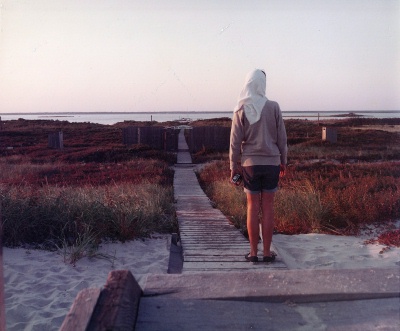
Fire Place Beach Club Boardwalk looking toward
Great South Bay and Fire Place hamlet.
Photo: © Marshall Bull
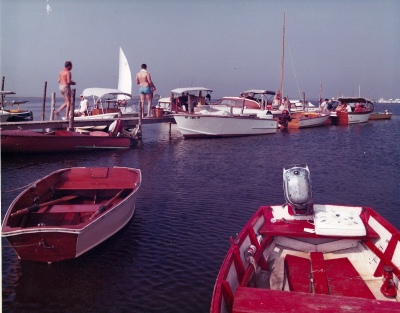
Boats and Dock at the Fire Place Beach Club
Photo: © Marshall Bull
Because of the way these two clubs evolved historically, Bellport’s Old Inlet club was more east of Brookhaven’s Fire Place Beach Club, just the opposite of the Villages’ position on the mainland. But we both used the Old Inlet channel to get to our respective beaches. As an aside, the Incorporated Village of Bellport was smart enough to realize the National Seashore was going to go out and buy property on the beach and they would have to automatically skip any incorporated village property so they bought what is today Ho-Hum Beach.
Then came the National Seashore. They [the Feds] were very friendly with Ted Everett [President Old Inlet Club] over the years, and I got together with Ted to see what we could do to see that whatever they offered us let’s make sure it was a fair deal. After a time both the Hospital Point and Mattabank Corporations were made offers, and I thought that was a fair offer for our piece, $32,000, nearly twice what we had paid for it a decade earlier, plus a couple of thousand extra for the boardwalk and the building. The Hospital Point Corp. was offered quite a bit more because they had five times as much property [25 acres] and after many discussions with Ted we decided that we’d take it. However, we decided we’d push for a lease back and make that a condition. We both met with the fellow doing the negotiating for the National Seashore at the same time, and we told him we would not challenge him on the price but we’d like to have a lease back and asked for five years. They agreed, we sold it to them, and we continued to run Fire Place Beach as before. The Mattabank stockholders made out quite well, receiving about $500 for their original $125 investment. But when our five years were up, they didn’t renew and tore up the Fire Place Beach Club dock, boardwalk and buildings.
A positive thing that came out of this is that the Brookhaven Village Association, which held a number of Mattabank’s stocks and bonds, received several thousand dollars and used that money to create the west canal at Squassux Landing. And, after the five year lease back of the Old Inlet Club, the National Seashore decided not to demolish the Old Inlet structures and said that this would be available to anyone with a boat and we could continue to have access to the beach as before, so we were happy that we still had access to the beach. But, as you know, the Federal government did not continue to do repairs and gradually everything fizzled out to what you see today, just a boardwalk crossing.
What the Old Inlet Club and the Fire Place Beach Club had in common was that our members liked boats, enjoyed going over to the beach, and going over there by boat was half the fun. They enjoyed swimming in the ocean and they all appreciated that the beach was one of the finest beaches in the world, and so it is, with the white sand, dunes, and to say nothing of the beach plums, which everyone picked in the fall. I think I mentioned that Dennis Puleston and Ted Everett drove up to Cape Cod at the suggestion of the Federal negotiator to see how the National Seashore was run there. Cape Cod is a little different in that they could get to most places by car. The barrier beach that we’re talking about you could only get to by boat. What I hope for now is that the National Seashore would maintain just two things: the boardwalk and the dock. If they do that we could continue to have access to the beach, just like Cape Cod. It’s just a small fraction of the amenities that the Old Inlet Club had. Heck, you could take a freshwater shower, you had your own bathhouse, your own locker. It was peaches and if you didn’t want to take a picnic lunch you could at least have a hamburger and a cup of coffee. And they [Old Inlet] made very nice chowder, by the way.

Old Inlet Club Viewed from the Fire Place Beach Club
Photo: © Marshall Bull
Interview and transcription by Marty Van Lith
Originally published in the Post-Morrow Foundation Newsletter, Fall 2003.
© Marty van Lith, 2009.

